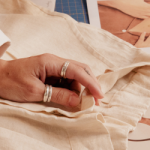Fashion Designing Technology and Fashion Design are converging more than ever in 2024. The synergy between creativity and technology is shaping the fashion industry like never before. This blog will delve into the fascinating realm of fashion designing technology, exploring how innovations are revolutionizing the way we design, produce, and experience fashion.
In this article, you’ll discover the latest technology trends that are reshaping the fashion industry in 2024. We’ll demystify the difference between fashion technology and fashion design and introduce you to the top 10 fashion-tech designers who are leading the way in this exciting fusion of style and innovation. So, buckle up as we embark on a journey through the fascinating world of fashion and technology.
Table of content
Technology Trends Reshaping the Fashion Industry in 2024
Difference Between Fashion Technology and Fashion Design
Top 10 Fashion-Tech Designers
Technology Trends Reshaping the Fashion Industry in 2024
Despite being one of the world’s largest industries, with a projected worth of up to $3.3 trillion by 2030, the fashion sector has surprisingly clung to many of its traditional practices over the past two decades. This is partly because sourcing low-cost manual labor in various countries and outsourcing production expenses has remained relatively uncomplicated. However, a shifting landscape marked by concerns about fair wages, environmental pollution, and the demands of today’s hyper-connected consumers has paved the way for exciting technological innovations.
We undoubtedly find ourselves in the “insta-age” of technology, where consumers expect immediate access to the latest fashion trends, thanks to the power of social media. Simultaneously, younger generations, seeking unique and personalized products, are moving away from “mass-produced” or “fast-fashion” clothing. This shift makes it increasingly challenging for brands to continue producing large quantities of clothing months in advance without knowing how well it will sell. In this rapidly changing landscape, companies that can adapt swiftly to market demands are poised for success.
To thrive in this evolving fashion landscape, many designers and brands are embracing cutting-edge technologies to push the boundaries of manufacturing, production, marketing, and wearability. As consumers’ real lives become more intertwined with the digital realm, technologies such as artificial intelligence, mobile commerce, 3D printing, and blockchain are becoming pivotal. Though there are several interior design courses available in the market but you can get a brief understanding here
1. Artificial intelligence
2. Novel fabrics
3. Internet of Things (IoT)
4. Rapid data analysis for quick adaptation
5. Mobile commerce
6. Virtual and augmented reality (VR)
7. Online vector editors
8. 3D printing
9. Blockchain
Ai-based inventory management
1. Artificial Intelligence (AI)
AI is a game-changer in fashion. It powers recommendation engines, predicting customer preferences with remarkable accuracy. Designers also employ AI to generate new design ideas and automate time-consuming tasks like pattern making. AI-driven virtual stylists assist shoppers in assembling outfits, enhancing their overall experience.
2. Novel Fabrics
Fashion is undergoing a materials revolution. Novel fabrics encompass sustainable textiles made from recycled materials, cruelty-free leather alternatives, and even smart textiles equipped with sensors. These innovative materials not only reduce fashion’s environmental impact but also open up new avenues for creative expression.
3. Internet of Things (IoT)
IoT transforms fashion into a tech-driven industry. Smart garments and accessories equipped with IoT sensors monitor users’ health, adjust temperature, or provide location-based recommendations. These wearables bridge the gap between fashion and functionality, enhancing consumer lifestyles.
4. Rapid Data Analysis for Quick Adaptation
Real-time data analysis is vital for agile fashion brands. By closely monitoring consumer trends, market dynamics, and inventory levels, companies can quickly adapt to changing demands. This data-driven approach streamlines the supply chain, reduces waste, and enhances customer satisfaction.
5. Mobile Commerce
The rise of mobile commerce continues to redefine the shopping experience. Mobile apps offer intuitive interfaces, personalized recommendations, and seamless payment options. Augmented reality (AR) features enable users to virtually try on clothing, boosting confidence in online purchases.
6. Virtual and Augmented Reality (VR/AR)
Fashion brands are leveraging VR and AR to create immersive experiences. Virtual fashion shows and showrooms allow consumers to engage with collections from anywhere. AR try-on apps enable customers to visualize how garments fit and look before buying, reducing returns.
7. Online Vector Editors
Collaborative design tools in the cloud empower fashion designers to work remotely and efficiently. These online vector editors facilitate real-time collaboration, version control, and the sharing of design concepts. This tech simplifies complex design processes.
8. 3D Printing
Additive manufacturing, or 3D printing, revolutionizes fashion production. It enables the creation of intricate and customizable designs with reduced waste. Designers can experiment with unconventional materials and shapes, pushing the boundaries of creativity.
9. Blockchain
Blockchain technology enhances transparency and traceability in the fashion supply chain. Consumers can verify the authenticity and origin of products, reducing the circulation of counterfeit goods. This fosters trust and supports sustainable practices.
Difference Between Fashion Technology and Fashion Design
The mentioned table will help you understand the difference between fashion designing and fashion designing technology:
| Aspect | Fashion Technology | Fashion Design |
| Focus | Emphasizes technology and innovation in clothing and apparel. | Centers on the creative and artistic aspects of clothing design. |
| Primary Role | Develops and applies technology for enhanced functionality and aesthetics. | Creates clothing designs based on artistic concepts and trends. |
| Skills Required | Proficiency in technology, software, and materials related to clothing production. | Strong artistic skills, creativity, and knowledge of fabrics and garment construction. |
| Scope | Involves wearable technology, smart textiles, sustainable materials, and production automation. | Encompasses garment design, pattern making, sewing, and fashion illustration. |
| Career Options | Fashion technologist, product developer, textile engineer, fashion tech entrepreneur. | Fashion designer, fashion illustrator, pattern maker, apparel stylist. |
| Innovation Focus | Integrates technology for functional improvements like smart clothing and performance wear. | Focuses on artistic innovation, trends, and creating visually appealing clothing. |
| Objective | Creating clothing that combines style, functionality, and technology-driven features. | Crafting garments that showcase unique design aesthetics and appeal. |
| Collaborations | Often collaborates with designers to realize technologically advanced fashion concepts. | Collaborates with fashion technologists to bring creative designs to life. |
| Examples | Wearable gadgets, 3D-printed fashion, sustainable fabrics, e-textiles. | Haute couture, pret-a-porter, fashion collections, fashion shows. |
This table highlights the key distinctions between Fashion Technology and Fashion Design, emphasizing their unique focuses, skill sets, and career paths.
Top 10 Fashion-Tech Designers
Today, the fashion industry witnesses a surge in fashion-tech designers who aim to push boundaries by creating wearables that enhance human capabilities and engage with the surroundings. Leveraging cutting-edge technologies such as 3D printing, artificial intelligence, augmented reality, and digital manufacturing, these innovative designers are reshaping the landscape of intelligent textiles.
We’ve curated a list of 10 visionary fashion-tech designers who are at the forefront of transforming the fashion industry through their groundbreaking ventures.
Here’s an overview of the top 10 fashion-tech designers:
- Iris van Herpen: Known for her avant-garde designs that blend fashion and technology, Iris van Herpen often incorporates 3D printing and laser cutting into her creations.
- Niccolò Casas: An Italian designer who explores the intersection of fashion and digital technology, creating garments with intricate details and innovative materials.
- Neri Oxman: A pioneer in the field of material ecology, Neri Oxman uses biology, engineering, and design to create groundbreaking wearables and architectural structures.
- Anouk Wipprecht: An interactive fashion designer who combines technology and couture to create garments that respond to the wearer’s movements and the environment.
- Behnaz Farahi: Behnaz Farahi specializes in responsive fashion, designing garments that can change shape and appearance based on external stimuli.
- Julia Koerner: Julia Koerner is known for her work in computational design and digital fabrication, using algorithms to create intricate and unique fashion pieces.
- Jessica Rosenkrantz: Co-founder of Nervous System, Jessica Rosenkrantz explores generative design and 3D printing to create jewelry and fashion items inspired by natural forms.
- Noa Raviv: Noa Raviv’s designs often blend traditional craftsmanship with cutting-edge technology, resulting in garments that challenge conventional notions of fashion.
- Jun Kamei: Jun Kamei specializes in biomimicry and biofabrication, creating garments inspired by nature and biology.
- Ganit Goldstein: Ganit Goldstein incorporates technology like 3D printing and laser cutting to create fashion pieces that bridge the gap between art, design, and technology.
These designers are pushing the boundaries of fashion with their innovative use of technology, materials, and design concepts.
























